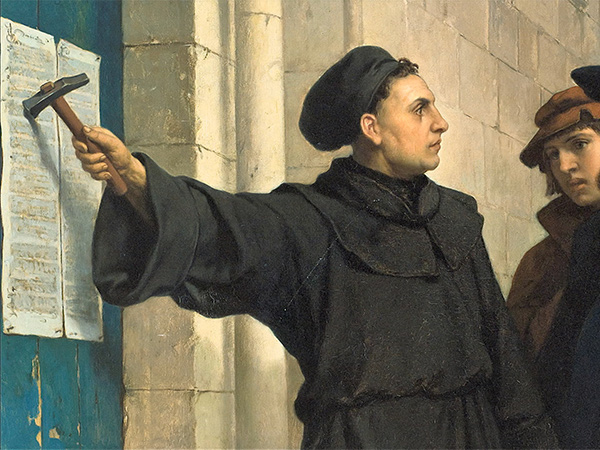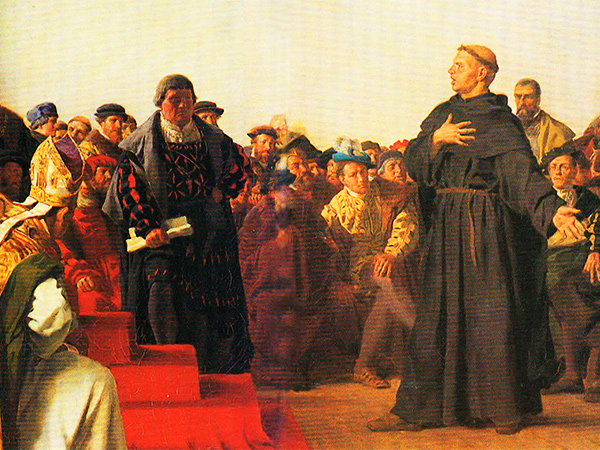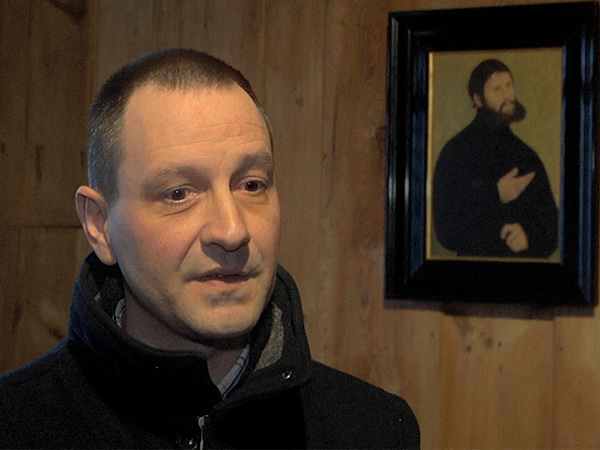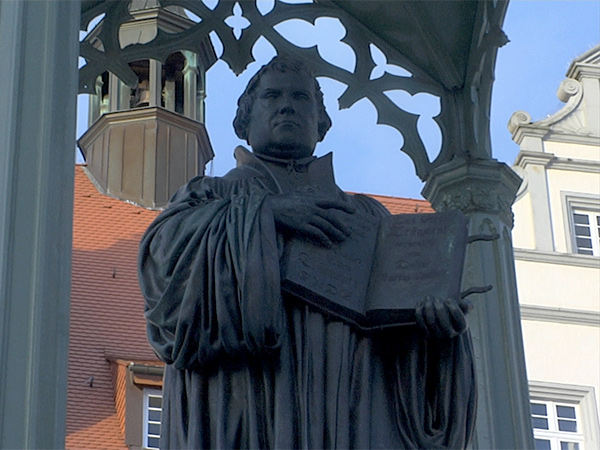In the Footsteps of Martin Luther
Follow along as managing editor Kim Lawton visits several key sites in Germany associated with Martin Luther and the beginning of the Protestant Reformation 500 years ago.
 KIM LAWTON, correspondent: We started our journey in the eastern German town of Eisenach. Martin Luther’s father Hans sent him to study Latin here in 1498 when he was 13 to study Latin. Luther lived in the church school and was part of a boys’ choir that went door-to-door singing to earn their keep. According to local legend, a wealthy woman in town liked his singing so much, she invited Luther to stay with her family. Today, the family’s home is called Luther Haus. It’s a museum with newly renovated interactive exhibits, including one that doesn’t shy away from discussing some of Luther’s anti-Semitic writings. By the way, Eisenach is also the birthplace of composer Johan Sebastian Bach, who was born in 1685.
KIM LAWTON, correspondent: We started our journey in the eastern German town of Eisenach. Martin Luther’s father Hans sent him to study Latin here in 1498 when he was 13 to study Latin. Luther lived in the church school and was part of a boys’ choir that went door-to-door singing to earn their keep. According to local legend, a wealthy woman in town liked his singing so much, she invited Luther to stay with her family. Today, the family’s home is called Luther Haus. It’s a museum with newly renovated interactive exhibits, including one that doesn’t shy away from discussing some of Luther’s anti-Semitic writings. By the way, Eisenach is also the birthplace of composer Johan Sebastian Bach, who was born in 1685.
When he was 18, Luther went to study law at the University of Erfurt, one of the most important German universities of the time. Erfurt was an important trade center in medieval Germany. Luther earned a bachelor’s and master’s degree and was headed toward a career in law. Then, according to tradition, in 1505, he was caught in a thunderstorm and nearly hit by lightning. As the story goes, he was terrified and asked St. Anne for help. He promised that if he survived, he’d become a monk. A short time later, to his father’s great displeasure, Luther entered Erfurt’s Augustinian monastery.
 MATTHIAS GOSE, Augustinian Monastery: He went into a monastery and he gave up everything. He was master of the university. In the medieval world, that counts something. But he has thrown it away.
MATTHIAS GOSE, Augustinian Monastery: He went into a monastery and he gave up everything. He was master of the university. In the medieval world, that counts something. But he has thrown it away.
LAWTON: Here, Luther lived the rigorous life of a monastic order. He followed the rules with intense prayer and fasting, but later said he could never find peace with God. At the monastery today, you can see the restored room where he worked and slept, along with some theology books with notes in the margins. Scholars have confirmed it is Luther’s handwriting. It was here that he read the Bible for himself for the first time.
GOSE: Martin Luther was a simple monk, a poor one, but, a monk with access to education.
LAWTON: You can also visit the Church of St. Augustine, where Luther presided over his first Mass. He was ordained a priest at the magnificent Erfurt Cathedral in 1507 and began working on his doctorate in theology. As he continued his religious studies, Luther increasingly wrestled with questions about his faith.
In 1512, Luther’s superiors sent him to teach theology at the new and still-unfinished University of Wittenberg.
 MIRKO GUTJAHR, Luther Memorials Foundation: When Luther came, he was quite disappointed. He said, well, this city is on the brink of civilization. I’m not sure which side of the brink it was.
MIRKO GUTJAHR, Luther Memorials Foundation: When Luther came, he was quite disappointed. He said, well, this city is on the brink of civilization. I’m not sure which side of the brink it was.
LAWTON: Luther lived in Wittenberg’s Augustinian monastery, which you can still visit. Luther came to believe that people were justified, or made right, before God, not through good works or the sacraments, but solely through their faith and God’s grace. He embraced the idea that the Bible alone is the ultimate spiritual authority, not the pope or the church as he had been taught.
GUTJAHR: He said the main focus of my thinking should be the Bible, the Holy Scripture. Nothing else, not the authority of ancient writers, not the authority of the church or modern people, but the Scripture itself, the word of God.
 LAWTON: Luther became disturbed by reports that a Dominican friar, Johann Tetzel, was taking large payments for granting indulgences, or releases from punishment for sins, including for the deceased. On October 31, 1517, Luther released a list of 95 theses, arguments against what he saw as this abuse of church practice. According to tradition, Luther nailed his theses on the door of Wittenberg’s Castle Church. At the time the door was wooden, although today it is encased in metal. There is no record of Luther actually posting his theses there, so some historians debate whether it really happened. It was common for scholars to post their debate points on the door where people could read them, so some scholars say it may have been too ordinary an event to document.
LAWTON: Luther became disturbed by reports that a Dominican friar, Johann Tetzel, was taking large payments for granting indulgences, or releases from punishment for sins, including for the deceased. On October 31, 1517, Luther released a list of 95 theses, arguments against what he saw as this abuse of church practice. According to tradition, Luther nailed his theses on the door of Wittenberg’s Castle Church. At the time the door was wooden, although today it is encased in metal. There is no record of Luther actually posting his theses there, so some historians debate whether it really happened. It was common for scholars to post their debate points on the door where people could read them, so some scholars say it may have been too ordinary an event to document.
Either way, Luther’s theses were mass produced on the newly-invented moveable-type printing press, and they were widely distributed across Germany.
GUTJAHR: There were other people criticizing the practice of selling indulgences at the time, but he was probably the loudest and the most visible.
 LAWTON: Luther gave a series of follow-up sermons which went further in questioning church authorities, including the pope. He preached many of those sermons at what is now Wittenberg’ Evangelical City and Parish Church of St. Mary’s. He preached more than 2,000 sermons here throughout his career.
LAWTON: Luther gave a series of follow-up sermons which went further in questioning church authorities, including the pope. He preached many of those sermons at what is now Wittenberg’ Evangelical City and Parish Church of St. Mary’s. He preached more than 2,000 sermons here throughout his career.
REV. JOHANNES BLOCK, Evangelical City and Parish Church: He could deliver very lively and he used a lot of pictures in his language, a lot of symbols and so the people could understand him and then, as a reformer, he was very popular and so the people and some prominent visitors wanted to see and to listen to him.
LAWTON: Of course, Luther’s radical ideas--and his growing popularity--deeply concerned church officials both in Germany and in Rome.
 GUTJAHR: They started to make the process against Martin Luther to collect legal actions against him because he was seen as a heretic. He was seen as one who spoke openly against the authorities of the church and that should be hindered that should be stopped.
GUTJAHR: They started to make the process against Martin Luther to collect legal actions against him because he was seen as a heretic. He was seen as one who spoke openly against the authorities of the church and that should be hindered that should be stopped.
LAWTON: Pope Leo the Tenth proclaimed Luther a heretic in 1520 and he was summoned to a church court in the city of Worms in April 1521. Luther refused to recant his beliefs. Emperor Charles the Fifth declared him an outlaw.
A local German prince, Friedrich the Wise, had Luther whisked away and hid him at the Wartburg Castle outside Eisenach. Luther spent the next ten months here disguised as a knight called Squire George. While he was here, Luther further popularized Reformation beliefs.
 FRANK SHOETZ, Wartburg Castle: Most of the time he was writing. Actually he was translating the New Testament. That’s the most famous work. But he wrote down other stuff, 13 smaller books and letters to his friends.
FRANK SHOETZ, Wartburg Castle: Most of the time he was writing. Actually he was translating the New Testament. That’s the most famous work. But he wrote down other stuff, 13 smaller books and letters to his friends.
LAWTON: After attending Mass in the chapel here, Luther also wrote church services in German, rather than Latin, so lay people could understand what was being said. And he introduced the idea of adding hymns that the congregation could sing.
Many of the castle’s beautiful interiors were installed after Luther’s time. But the room where he worked is authentic. The furniture was not his, except for the whalebone footstool, which experts say Luther did use.
By the time Luther returned to Wittenberg, Reformation ideas had been widely embraced, and sometimes, in Luther’s opinion, they were taken too far. He lived at the monastery, which was now no longer a monastery, and continued to write and preach. And he did something which surprised many of his followers: he married a runaway nun, Katharina von Bora. They had six children together.
 As tensions between Catholics and the so-called Protestants continued to rise, Luther condemned violence that was breaking out in some areas. He continued debating theology on many fronts and became increasingly harsh against those who disagreed with him. Most notable were his derogatory writings about Jews after he was angered that they didn’t convert to Christianity.
As tensions between Catholics and the so-called Protestants continued to rise, Luther condemned violence that was breaking out in some areas. He continued debating theology on many fronts and became increasingly harsh against those who disagreed with him. Most notable were his derogatory writings about Jews after he was angered that they didn’t convert to Christianity.
GUTJAHR: He got convinced that well if they don't come to the light as I showed to them they must be of the evil. Fortunately, we’re now 500 years later. We’re wiser. But still, it might explain why Martin Luther was acting in this way, because he thought them to be influenced by the devil.
LAWTON: Luther died in 1546 and is buried at Wittenberg’s Castle Church. At the City and Parish Church, he is memorialized in an altar painting done by his friend Lucas Cranach. In one panel, Luther is sitting with Jesus and the disciples at the Last Supper. In another, he’s at his spot in the pulpit, preaching while pointing to Jesus on the cross. Both churches have been named UNESCO World Heritage Sites.
Follow along as managing editor Kim Lawton visits several key sites in Germany associated with Martin Luther and the beginning of the Protestant Reformation 500 years ago.